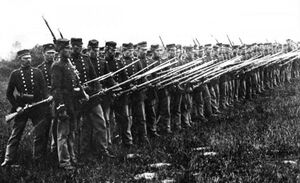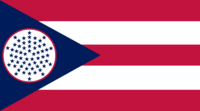Belfrasian Army
| Belfrasian Army Exercitus Belfrasiana | |
|---|---|
Logo of the Belfrasian Army. | |
| Founded | 1850 |
| Country | |
| Allegiance | Belfrasian Federation |
| Type | Army |
| Size | 260,000 active |
| Patron | Saint Michael |
| Engagements | Western rebellions First Belfro-Elatian War Belfro-Mutulese war of 1911 Belfro-Mutulese War of 1928 Second Belfro-Elatian War Social War Enyaman Civil War Ayeli Civil War Tikal Crisis |
| Commanders | |
| Secretary of the Army | Flavius Sallustius Tremorinus |
| Head of the Army Council | PLEG Herius Caesonius Melitus |
| Optio Exercitus | Martinus Cervius |
The Belfrasian Army, formed in 1861, is the land force of the Belfrasian Federation. It along with the Federation Navy and Belfrasian Air Force make up the Belfrasian Armed Forces. It is the largest of the three branches and is in charge of ground warfare. The army is headed by a civilian appointed civil servant, the Secretary of the Army (SECARMY) and by the Head of the Army Council, typically a Praefectus Legionis, who heads the council and overall army command.
History
Federalisation and first Belfro-Elatian war
The united Belfrasian Army came into existence in the Federalisation of the Latium dependencies in 1855.
Structure and Organisation
The Belfrasian Army is maintained by the Secretary of the Army and commanded by the Chief of Army Staff. The former is filled by a civilian politician or civil servant who is party-dependent and is typically replaced when a new President is elected to office whilst the latter is a senior army position held by the highest ranking general. Ever since the Army's creation in the late 19th century the Secretary of the Army has always stayed out of the way of operational affairs, with the Chief of Army Staff in turn allowing the Secretary to financially maintain the Army and to confer wishes and requirements to the Chief of Army Staff to fulfil.
A full-scale reorganisation of the army in 2005 resulted in the Army having seven operational divisions; Two divisions were geared up for heavy, armoured combat, three divisions were geared for light, mobile operations with the ability to quickly upgrade to heavier armoured vehicles if needed and finally another two divisions were geared similarly to the lighter divisions but for operations for helicopter/airborne assaults and mountain warfare.
Combat divisions of the army are comprised of six regiments; A headquarters regiment that houses the division's command units, military police elements and division-wide units such as engineers, air defence and signals. Three regiments are 'line regiments' and are the main combat bulk of the division with the final two regiments being an aviation regiment and an artillery regiment which holds the division's aviation assets and artillery units respectively. This set-up has allowed divisions to operate over a long duration in combat situations without the assistance of other combat divisions.
In the event of a deployment to a foreign country, the army puts together 'Expeditionary Commands'. The smallest of these commands it the 'Expeditionary Brigade' which is attached to two combat regiments and is fulfilled with an extended sustainment unit, air defence units and provides capabilities to the two regiments that a standard division would, albeit smaller and far more manoeuvrable. The largest, an Expeditionary Force does likewise but for an entire division. The Expeditionary Force attaches units from the Air Force and reserve units to provide the deploying division with wholly extended capabilities in aviation, air defence, logistics and sustainment.
The Belfrasian Army currently consists of seven active divisions, three reserve divisions, and a 'Rapid Deployment Brigade', which is a permanent on-standby formation of light mobility units capable of rapid deployment anywhere in the world in response to rapidly evolving events or in support of special operations. The Army also operates a regiment-sized training unit that helps maintain standards within the Federationan Guard.
| Primary Commands | |||
|---|---|---|---|
| Name | Current Commander | Headquarters | Responsibilities |
| Army High Comand | FM Herius Caesonius Melitus | Thessalona, Salonika | * Maintain Primary and Secondary commands * Provide the Federation with combat-ready forces capable of deployment to regional commands |
| Army Material Command | GEN Augustus Calventius Tremorinus | Armas, Lyressa | * Research and development of military materials * Maintain and distribute military materials * Maintenance of primary logistic chains |
| Army Personnel Command | GEN Liburnia Vera | Thessalona, Salonika | * Manage recruitment, training and in-service education of personnel * Assist Military Council with development of ground-based tactics and strategies * Act as administrative command to duty-unit financial aides |
| Secondary Commands | |||
| Army Medical Command | GEN Caelus Favonius Paenula | Thessalona, Salonika | * Development and distribution of medical knowledge and instruments * Establishment, maintenance, and operation of Army medical centres at home and abroad * Act as primary administrative command for primarily medical personnel (Doctors, dentists, etc) |
| Army Veterinary Command | LTG Kaeso Papirius Auxilius | Thessalona, Salonika | * Recruitment and training of military working animals * Selection and training of Animal handlers * Through-career care of animals * Housing and after-care of animals post-retirement |
| Army Aeronautical Command | LTG Julianus Suedius Elerius | RAD Agrinio, Eribia Minor | * Administrative manage in-service maintenance of fixed-wing and rotary aircraft * Research and develop new flying techniques and materials in partnership with suppliers and Material Command * Create and maintain new flying standards within the Army. * Act as primary liaison with the Federation Air Force. |
| Army Special Forces Command | GEN Georgius Lucioni | Koronia, Chrysopolia | * Manage selection and training of personnel into special forces * Administrate in-service special operations units on operations and at home * Manage special aviation units in partnership with Federation Air Force. |
| Combat Divisions | |||
| Name | Current Commander | Headquarters | Subunits |
| I Divisio Cataphractarius | MG Septimus Lucceius Tertius | Fort San Cristos, Lyressa | XII, V Legiones Catafractorius XVI Legio Pedites Loricatorum II Ala Tormentorum |
| II Divisio Mechanicum | BG Caius Baebius Marcellus | Fort Roger Westerly, Patrinos | III, XVII Legiones Catafractorius I, XXI Legiones Pedites Loricatorum IV Ala Tormentorum |
| XX Divisio Mechanicum | LTG Camillia Iusta | Fort Kozani, Stronkeia | X, XVIII Legiones Catafractorius XX Legio Pedites Loricatorum VI Ala Tormentorum |
| III Divisio Cataphractarius | MG Spurius Manilius Asina | Fort Agrippos, Peloponasia | IV, XIX Legiones Catafracotorius VII Legio Pedites Loricatorum I Ala Tormentorum |
| VII Divisio Pedites | LTG Potitus Canius Assanius | Fort Thesseus, Kalamos | II, IX, XV, XXII Legiones Pedites Loricatorum III Ala Tormentorum |
| LIV Divisio Aerium | MG Robertus Luzi | Fort Kankrattos, Aunogostos | VI, XIV, XXIII Legiones Pedites Aerium V Ala Tormentorum |
| IX Divisio Equitum | MG Lucius Domitius Seuso | Fort Lemnos, Megos Delphoria | VIII, XI, XXIV Legiones Pedites Equitum VII Ala Tormentorum |
| Reserve Divisions | |||
| XXXIV Divisio Equitum | BG Artemona Candidius | Fort Koureze, Eribia Minor | |
| LXI Divisio Pedites | STRA Philoxenus Quatruus (Acting) | Fort Iolcoezen, Agonon | |
| LI Divisio Aerium | BG Severus Lucretius | Fort Hellopeion, Kannis | |
| Active sub-units | |||
| IX Ala Discplina | COL Periphanes Calacicus | Reserve Station Alamyer, Pelopanasia | N/A |
| Divisio Reactio Rapidus | BG Jorg Grubbenheimmer | RAD Pottersfield Green, Samos | |
Personnel
Uniforms
The uniforms of the Belfrasian Army distinguish the members of it's organisation from those of other services and originally had been influenced by Latin military traditions and then civilian fashion trends. In the modern military the uniform is heavily reliant on utility and ease-of-wear and separates this into three primary categories: Combat, Service, and Dress. Combat uniforms are worn in operational environments and focus on being able to carry the wearers equipment and protective body-armour whilst also being light enough not to overheat the wearer during physical exertions. Service uniforms are worn by officers and enlisted for semi-formal functions such as a court-martial, making official visits, visiting places on any army-warranted duty with special dispensation, reporting for duty, or when permitted by a commanding officer. Finally, the dress uniform is the formal and ceremonial uniform of the Army and is worn at formal functions. The dress uniform has a sub-uniform, called the evening dress, which is worn at 'white tie' events.
Designs of the earliest army uniforms didn't differentiate between combat and service dress, opting for intricate designs based on Latin uniforms. The first regulations in the army called upon a red tunic with gold stitching for front chevrons, two for a basic soldier and five for an officer. The tunic would be worn with white trousers and black polished boots. At this point infantrymen would wear a tricorne hat, with a feather to designate the unit as an 'honored' unit within the army. Artillery operators would wear an apron alongside engineer units and be allowed not to wear any hats when utilising artillery pieces to avoid them being blown off by the rush of air following firing.
Combat Uniforms
The combat uniform of the Belfrasian Army is intended for usage when in the field, an environment where physical exertion is likely or in an environment in which the wearer may dirty his or her uniform in the course of executing their orders. The uniform, sometimes referred to as 'utilities' by personnel within the army, was designed to used with body armor, with pockets that would be available for usage with armour on or rapidly with minor alterations to the wearers equipment vest.
The blouse of the utilities features two angled chest pockets and sleeve pockets featuring velcro and button closure respectively. The elbows of the sleeves, whilst fully capable of being rolled up, are reinforced as to survive rugged usage without elbow pads. The cuffs of the uniform feature adjustment straps and a small rigged line shows the wearer where the sleeve needs to be rolled up to when wearing the blouse with the shirts rolled up. The shoulders of the blouse are reinforced and padded to help carry the weight of an equipment vest or backpack without chafing the wearers skin. The trousers of the utilities is similarly designed to aid the wearer when necessary; The trousers features two deep pockets at the hip, two rear pockets with button closure and two thigh-level cargo pockets with a combined velcro and elastic closure. The seat and knees of the trousers are reinforced similar to the elbows of the blouse to help minimise wear and tear with frequent use. The fly of the trousers is operated by buttons and is concealed behind a flap. The bottom cuffs of the trousers are equipped with an internal elastic system to help keep it tucked into their boots as per dress regulations.
Wearers of the uniform wear an green, blank t-shirt underneath the blouse. The t-shirts are made with breathable materials to help keep the wearer cool in hot environments. Boots worn with the uniform are tan combat boots and feature anti-stain materials and a reinforced heel and toe to protect against wear and to protect the users feet when in use. Headwear with the uniform is primarily a beret, coloured to match the wearers operational branch. Other headwear authorised includes a boonie hat, a campaign hat for instructors, a tan baseball cap for high-heat environments, and of course combat headgear such as the lighttweight helmet.
When operating in environments that call on the user to don armoured protection systems, the Army have a combat shirt that is to be worn instead of the blouse in hot or warm climates. The shirt is constructed with lightweight, breathable fabrics that absorbs sweat and moisture from the body to improve user comfort. The materials used in construction of the shirt are flame resistant, which when combined with the in-service trousers which are also constructed with flame resistant gear provide the wearer with toe-to-neck protection against burns.
A recent entrant to the uniforms of the army is an upgraded version of the combat shirt, called the armoured shirt. The armoured shirt was introduced with a lighter, more modular body armour vest that is both stream-lined whilst also offering more protection when coupled with the armoured shirt. The armoured shirt matches the new body armour system with it's modularity with soft, flexible armour built into the shirt along the neck, shoulders and high chest and back areas. The armour built into the shirt is approved for protection against shrapnel and 9mm rounds whilst also maintaining the light, breathable nature of the combat shirt. The added protection on the upper arms and shoulder by the shirt remove the need for add-on armour for the shoulders, which was proven to be bulky and prone to snagging on objects when mobile, possibly endangering the wearers life in a combat situation. The armour built into the shirt gives the same level of protection for the shoulders and upper arm area whilst also adding protection to the neck and reinforcing protection to the upper thorax region which is already protected by the worn armoured vest. Tests conducted in 2013-2014 proved that the new shirt/vest system shaves off at least 15 percent of existing weight that the soldier has to carry.
Service Uniforms
The current service uniform was brought into use in 1948 and is worn by all officers and enlisted personnel at semi-formal events or events in which do not call for the dress uniform to be worn. It standardised the army's service uniforms which had been varied between divisions until then. The uniforms it replaced were the cream-and-black uniform in service in 1892, the 'Deslen White' dress worn by the 1st Infantry Division, and until the inception of the current service uniform each division's uniform had several pieces 'gifted' to them by international governments as part of a cultural exchange. The service uniform in usage today consists of khaki and green colours with a black tie along with either gold or silver buttons and decorative pieces for officers and enlisted respectively.
The uniform in it's entirety consists of an olive-green coat and trousers and a khaki long-sleeve button-up shirt, a black tie and polished black shoes. The coat is tailored for the wearer to be semi-form fitting and features two inside pockets, two chest pockets and two pockets along the waist. Epaulettes on the coat are utilised to display an officers rank as necessary but are used as a clap for service aiguillettes that run from the top of the right epaulette, under the right army, and back around on itself. The colour of the aiguillette is depends on the 'branch' of the army the wearer serves in. Most units in the Army utilise a red aiguillette, but artillery and engineer units wear gold, and infantry, airborne, cavalry, and armoured units wear blue. The medical corps of the army and the military police also do not wear the standard red aiguillette, wearing a white one in it's place, with the military police also wearing a white belt on their coat. High command personnel wear the aiguillette of the division they were a part of prior to joining high command with the addition of one aiguillette for each 'star' they have. High command personnel also wear a black belt around their coat. Enlisted personnel have their rank stitched onto the upper arms of their coat in gold with a khaki background, outlined with black stitching. Officers have their rank displayed on their epaullettes. The collars of the coat are decorated by branch insignia, such as crossed muskets for infantry. A pair of buttons are worn above the branch insignia, the one worn on the left collar is engraved to match the branch the wearer is a part of, such as the infantry's crossed muskets or the medical corps' Caduceus. The badge on the right collar is engraved with a star, representing the stars on the Belfrasian flag. An all-weather coat is permitted for wear in winter conditions or the rain in a khaki colour to match the shirt worn under the coat.
Multiple types of head wear is allowed within the Army. The most common is the dark olive-and-black peaked cap with is adorned with the native-Belfrasian falcon-god of war with traditional officer/enlisted variants of gold and silver. A beret is allowed to be worn in Class B and C uniforms as well and matches the worn aiguillette with few exceptions. Finally, the campaign hat is worn by members of enlisted or officer training schools.
Service uniforms in the army are designated the following with their usage:
- Class A is the base uniform worn with full-sleeve button-up khaki shirt, black tie and coat. Some events call for the coat to be removed when indoors, at which point it is not down-graded to a Class B since the the shirt underneath would still be long-sleeve and missing the division-specific markings such as the aiguillette and collar pins.
- Class B is sometimes refered to as the dress-down variant of Class A. The coat is removed in all circumstances with aiguillette and collar pins transferred to the long-sleeve shirt underneath. In colder climates, an olive sweater may be worn.
- Class C changes on Class B with a short-sleeve khaki shirt, with the shirt adorns the aiguillette and lower collar pins of the Class B uniform. The shirt is still a short-sleeve variant of the Class The tie may be removed in situations of extreme heat with the top button undone and collar folded flat so the collar is horizontal to the ground.
Dress Uniform
The Dress Uniform of the Federation Army has been in usage in many forms since independence was achieved in 1862 and is an elaborate uniform worn for formal and ceremonial occasions and meets the equivalent to the civilian black and white tie dress codes. There are two primary variations of the Dress Uniform: Dress Black and Evening Dress.
The Black Dress uniform or 'Dress Blacks' is the standard dress uniform of the Army. It was first shown in public at the funeral of President Claudius Krennistos in 1891 and has been in service since. It is used for ceremonies in which would be considered a 'black tie' affair. The uniform calls for black coat and trousers and a white button-up long-sleeve shirt worn underneath the coat. The trousers have are zip-ups with a black flap to cover the zip when done up properly with a black leather belt and a silver/gold buckle for enlisted/officers respectively.
Smart lace-up shoes are worn in polished black with a metal plate built into the rubber heels to produce an audible clicking noise when walking, although this is able to be removed when not going on parade. The coat matches the trousers in being black with two chest pockets and two pockets at the bottom of the coat along with two internal pockets for usage as required.
The coat is equipped with a pull-line along the bottom and a 'clip' to connect the bottom parts of the coat together in order to bring it flush with the body. The sleeves are decorated with a reinforced cuff that slants into the body, service stripes are worn in red along this part of the sleeves. Epaulettes on the coat are attached with a silver/gold button for enlisted/officers and the collar of the coat and shirt underneath are raised to be flush with the neck and attached with small silver/gold pins.
The coat is worn with a white belt featuring a buckle adorned with the Federation Star. The buckle is, again, either silver or gold to denote enlisted and officers respectively. Similar to the Service Uniform, branch aiguillettes are worn from the right epaulette but now attach to the coat's top-most button and are full-length aiguillettes with twin silver/gold pins that hang down along the front of the uniform. Headgear worn in Dress Blacks is black version of the peaked hat worn with the service uniform.
Members of the military police further augment their white belt with a white strap going from left of the buckle to under the right epaulette and back. Their hats are similarly changed to being a slate white to match the belts. Officers who have been issued a sword may wear it with this uniform.
Finally, noted on both the trousers and jacket of the uniform are reed linings along the sides of the trousers, on the cuffs of the coat, along the edges of the coat and on the epaulettes and neck. This is known as the 'blood stripe' of the uniform and was put into a uniform update in 1952, with the stripe signifying the men and women of the Army who had perished in it's historical wars.
The Evening Dress was adopted for service in 1897 and adapted a civilian tail coat to be worn with a tie and vest. The uniform matches the Service Black with black colouring and blood striping along the trousers and epaulettes. The trousers are pressed black and are zip-up with a fabric cover for when not in use. The trousers sport a single blood stripe as opposed to the Dress Black's two. The dinner jacket of the service uniform is decorated by six silver/gold buttons, two connecting buttons for doing up the dinner jacket when not being worn to keep it from creasing. The sleeves of the jacket sport red cuffs as an addition to the tribute to fallen soldiers and sport service stripes in gold stitching regardless of status as enlisted or officers. The ranks are identically displayed as with dress blacks but with medical staff having red 'blood stripes' stitched between their chevrons if enlisted. The dinner jacket has grey lapels which are changed to gold for evening dress uniforms worn by general staff members.
The blouse of the uniform is frilled, white and a button-up long-sleeve. It compliments the bow-tie, which is black regardless of the uniform being worn at 'white tie' events. Branch aiguillettes return with the uniform, worn from the right epaulette to a connecting button under the right lapel. An elastic support system hidden under the lapel shares the off-sided weight to the other side of the uniform to keep any weight imbalances from becoming an issue. Finally a red cummerbund is worn and hides the black leather belt on the trousers. Officers exchange the red cummberbund with a red waistcoat. In inclement weather black cloak with red colourings on the inside is worn and ceremonial swords may be worn with the supporting belt hidden under a cummerbund or waist coat.
Commissioned Officers
There are multiple paths to become a commissioned officer within the Belfrasian Army. The direct routes are through the Military Colleges and the Reserve Officers' Training Regiment. Enlisted personnel may progress to earning a commission through the Officer Candidate Academy and are granted full rights, privileges, and ranks as if they had gone through a Military College. Certain professions, such as physicians, pharmacists, dentists, lawyers, and chaplains are commissioned directly into the army and possess unique insignia and rank names.
Most commissioned officers are promoted based on a requirement system. Officer's are informed that they are to be promoted, either through acts in the field, time, general experience, or requirement, and may accept or refuse. In most cases, however, refusal almost always results in being removed from command in favor of an officer willing to accept the promotion. This has been at the base of several controversies over the history of the army, but it has always been argued that it's selection of officers has always bred excellent results in the field.
Senior officers, or Generals, are always addressed as 'General (Last Name)' regardless of exact rank. Likewise, Colonels and Lieutenants are referred to as 'Colonel (Last Name)' and 'Lieutenant (Last Name)' respectively, regardless of exact ranks.
| Pay Grade | AO-C | AO-1 | AO-2 | AO-3 | AO-4 | AO-5 | AO-6 | AO-7 | AO-8 | AO-9 | AO-10 | AO-11 |
|---|---|---|---|---|---|---|---|---|---|---|---|---|
| Insignia | 
|

|

|

|

|

|

|

|

|

|

|

|
| Title | Officer Candidate Officer Cadet |
Second Lieutenant |
First Lieutenant |
Captain | Major | Lieutenant Colonel |
Colonel | Brigadier General |
Major General |
Lieutenant General |
General | Field Marshal |
| Abbreviation | CAN CAD |
2LT | 1LT | CPT | MAJ | LTC | COL | BG | MG | LTG | GEN | FM |
| Note: Field Marshal leads Military Council and is elected from among sitting Generals. | ||||||||||||
Warrant Officers
| Pay Grade | OP1 | OP2 | OP3 | |
|---|---|---|---|---|
| Insignia | 
|

|

| |
| Title | Warrant Officer | Chief Warrant Officer |
Master Chief Warrant Officer | |
| Abbreviation | W-1 | W-2 | W-3 | |
Enlisted Personnel
Corporals and up are referred to as NCOs, or Non-Commissioned Officers. This is to distinguish the rank of Corporal from other ranked specialists who are at the same pay grade but do not have the same leadership responsibilities. A Corporal leads a section of two four-man fire teams, with a Lance Corporal acting as both the leader of the second fire team and as the second in command.
| MoD Pay Grade | E-1 | E-2 | E-3 | E-4 | E-5 | E-6 | E-7 | ||||||
|---|---|---|---|---|---|---|---|---|---|---|---|---|---|
| Insignia | 
|

|

|

|

|

|

| ||||||
| Title | Private | Lance Corporal | Corporal | Sergeant | Staff\Colour Sergeant |
Master Sergeant |
Sergeant Major | ||||||
| Abbreviation | PVT | LCOR | CORP | SGT | SSGT | MSG | SGM | ||||||
| ¹ NOTYETFILLEDIN | |||||||||||||
Training
Candidates for the Belfrasian Army undergo a common basic training scheme to bring all personnel up to a similar standard of basic military skills and understanding prior to further, specialised training being conducted. The specialised training itself is tailored by both the Belfrasian Military Training Command and the Regiment of which the individual has been assigned to upon finishing training. Training is divided over three phases, with the third phase being a loosely defined term in which soldiers in the Army are capable of gaining civilian qualifications or to further their skill-sets for wider opportunities when in the military.
The selection process for training are similar to that of other services in the Armed Forces. The process involves a number of suitability interviews, an aptitude test to identify potential specialisations, and a medical and fitness test. Potential Enlisted-level recruits have the opportunity to select a Regiment and a trade they wish to join, with later training orientated around this decision. Potential officer's, on the other hand, apply for sponsorship's from a regiment instead. When a regiment sponsors a potential officer, it guarantees a placement within it's organisational structure for that person once they finish candidacy training. However, the sponsorship only lasts three months over the training period to force the potential candidate to enter training as soon as possible.
Phase One training is similar regardless of desired specialisation or if the recruit intends to become an officer or an enlisted-level entrant. Phase One intends to bring all personnel up to a base competency for operations in the field, force protection, operational security, and general survivability including basic life saving training and marksmanship skills. This period of training lasts fourteen weeks, with a fifteenth week preparation for a 'Passing out Parade', in which the recruits formally finish Phase One and move onto Phase Two training following a two week rest period in which the recruits are able to mingle with family and friends. Despite this leave, recruits are still banned from leaving the country and are discharged if they are found to have broken this rule or have committed a criminal offense.
Following the conclusion of Phase One and the rest period, recruits are assigned to specialized training units around the country in order to qualify in their chosen specialities. It is at this point that the recruits are formally inducted into their chosen Regiments and have their trainings overseen by their commanding officers.
Equipment
Small Arms
| Model | Image | Origin | Type | Caliber | Details |
|---|---|---|---|---|---|
| Pistols | |||||
| Apion 10 | 
|
Semi-automatic pistol | 9×19mm NS | To be replaced by Apion 20 | |
| Muzaka Model 20 | 
|
Semi-automatic pistol | 11.43×23mm (.45 ACP) | Limited use | |
| Apion 20 | 
|
Semi-automatic pistol | 9×19mm NS | ||
| Submachine Guns | |||||
| NA-50 Submachine Gun | 
|
Submachine Gun | 4.6mm | ||
| NA-45 Submachine Gun | 
|
Submachine Gun | 9x19mm NS | Utilised by military police and special forces. | |
| Rifles/Carbines | |||||
| BR-55 Assault Rifle | 
|
Assault rifle | 5.56×45mm NS | Standard service rifle, older variants issued to Federal Guard. | |
| BR-55C Carbine Rifle | 
|
Carbine Rifle | 5.56×45mm NS | Standard service rifle. | |
| BR-70 | File:Scar L Standard.jpg | Assault rifle | 5.56×45mm 7.62×51mmNS |
In use with special forces | |
| BR-090 Assault Rifle | <imgur w=150>8CrJfxm.png</imgur> | Assault rifle family | 5.56×45mm/7.62×51mm NS | Replacing BR-055 as standard rifle of the Army. | |
| Shotguns | |||||
| Mossberg 500 | Pump-action shotgun | 12 Gauge/20 Gauge | |||
| Machine Guns | |||||
| NA-280 LMG | 
|
Light Machine Gun | 5.56×45mm NS | Can be felt-fed or utilised with STANAG magazines. | |
| NA-250 GPMG | 
|
General-purpose Machine Gun | 7.62×51mm NS | Belt-fed. | |
| NA-3 HMG | 
|
Heavy Machine Gun | 12.7mm NS | Mounted on vehicles or tripods | |
| DMRS and Sniper Rifles | |||||
| NA-620 SWS | Sniper Rifle | 7.62×51mm NS | Bolt-action | ||
| NA-720 AMSWS | Anti-materiel rifle | 12.7x99 | Bolt-action | ||
| NA-760 AMSWS | 
|
Sniper Rifle/Anti-Material Rifle | 14.5x114mm / 20x82mm / 20x110mm | Bolt-action | |
| NA-710 SWS | 
|
Designated Marksman Rifle | 7.62×51mm NS | Semi-Automatic | |
| Portable Anti-Material Weapons | |||||
| Crossbow | Unguided Anti-Tank Weapon | 67mm | Disposable one-shot weapon | ||
| AT48 Recoilless Rifle | File:At84 recoilless rifle.png | Unguided Anti-Tank Weapon | 84mm | ||
| MBT LAW | 
|
Disposable guided AT launcher | 150mm | ||
| Vanguard missile | 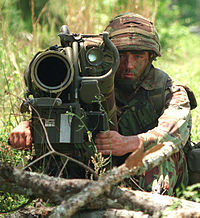
|
Anti-tank guided missile | |||
| Pike Missile | TBA | Guided munition | 40mm | Fired from grenade launchers and guided via designator | |
| Vesper missile | File:Vesper missile.png | Guided Anti-Tank Weapon | n/a | Fitted on vehicles and shoulder-launched. | |
| Explosives | |||||
| L109A1 | 
|
Fragmentation Grenade | n/a | ||
| ARGES mine | File:ARGES mine.png | Off-route Anti-Tank mine | n/a | ||
| L9 Bar Mine | Anti-Tank mine | n/a | |||
| L10 Ranger Anti-Personnel mine | 
|
Anti-personnel mine | n/a | ||
Artillery
| Model | Image | Origin | Type | Caliber | Details |
|---|---|---|---|---|---|
| Mortars | |||||
| Howitzers | |||||
| Rocket/Missile Artillery | |||||
| TDI Ares | 
|
Multiple rocket launcher system | X | Armored, self-propelled, multiple rocket launcher | |
| Raeda MARS | 
|
Wheeled advanced rocket system Vertical-launch missile system courier |
X | ||
| Theatre/Strategic Artillery | |||||
| ACM-7 Astaroth | Two-stage, Quasi-ballistic missile | X | |||
Wheeled vehicles
| Name | Image | Origin | Type/Variants | Number in Service | Details |
|---|---|---|---|---|---|
| BMI Jaguar | 
|
Utility Vehicle Family | x | In service as on-base/friendly territory utility vehicle only | |
| Pangolin MRAP | 
|
Mine Resistant Ambush Protected modular vehicle | x | ||
| Tamandua LTV | 
|
Light multi-role tactical vehicle | x | Slated to replace the Jaguar as deployment vehicle | |
| BMS Weasel | 
|
Armoured scout vehicle Tank Hunter Anti-Air Vehicle |
x | ||
| BMS Orestes | 
|
Armoured Personnel Carrier Infantry Fighting Vehicle Mobile Gun System |
x | ||
| Raeda MTV | 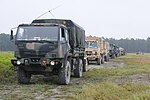
|
Medium multi-role tactical vehicle | x | ||
| Ferret FUTV | 
|
Ultra-light UtilityVehicle | x | ||
| Polecat PCV | 
|
Ultra-light Combat Vehicle | x | ||
| Rhinokeros MRAP | 
|
Mine Resistant Ambush Protected modular vehicle | x | ||
| Carrus HTMV | 
|
High-Threat Mobility Vehicle | x | 4x4 variants utilised by special forces only 6x6 variants in general usage | |
| Elephantus HTV | 
|
Heavy multi-role tactical vehicle | x |
Tracked vehicles
| Name | Image | Origin | Type/Variants | Number in Service | Details |
|---|---|---|---|---|---|
| Parmenio | 
|
Main Battle Tank Armored Recovery Vehicle Armored Engineering Vehicle Bridge Layer Assault Breacher |
x | ||
| Harma | 
|
Infantry Fighting Vehicle Light Tank Reconnaissance Vehicle Anti-Tank Vehicle |
x | ||
| Incitatus | 
|
Light tank | x | ||
| Testudo | 
|
Armoured personnel carrier Tank Destroyer Mortar Carrier |
x | Remaining variants to be replaced by new Harma models from 2018 onwards |
Water-craft
Aircraft
| Name | Image | Origin | Type/Variants | Number in Service | Details | |
|---|---|---|---|---|---|---|
| Helicopters | ||||||
| Clios Peregrine | 
|
Utility Helicopter Multi-Mission helicopter Electronic-Warfare Helicopter |
x | |||
| Aigios Stork | 
|
Troop/Cargo Assault Helicopter | x | Being phased out by Aigios Raptor | ||
| Clios Buzzard | 
|
Observation Helicopter Forward Air control Multi-Mission Helicopter Attack Helicopter |
x | |||
| Aigios Aquila | 
|
Attack Helicopter | x | |||
| Aigios Heron | 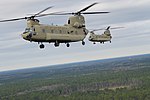
|
Transport Helicopter Multi-Mission Helicopter |
x | |||
| Aigios Raptor | 
|
V/STOL multi-mission aircraft | X | |||
| Unmanned Aerial Vehicles (UAVs) | ||||||
| OAT Needle | 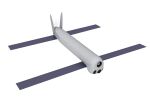
|
Light loitering munition | x | |||
| TI Szalinski | 
|
Hand-launched micro UAV | x | |||
| OAT Renattu | 
|
Hand-launched UAV | x | |||
| TI Oculus | 
|
Reconnaissance UAV | x | |||
| Clios Dragonfly | 
|
Hand-launched UAV | x | |||
Retired
- Bladed Weapons
- Pistols and revolvers
- Rifles, Carbines, and Muskets
- Submachine guns
- Machine guns
- Explosives and Launchers
- Ground vehicles
- Aircraft
- Watercraft

